Ukuleles continue to grow in popularity and are attractive to musicians for many reasons. The most common reasons are that they’re fun, easy to play, and perfect for all ages!
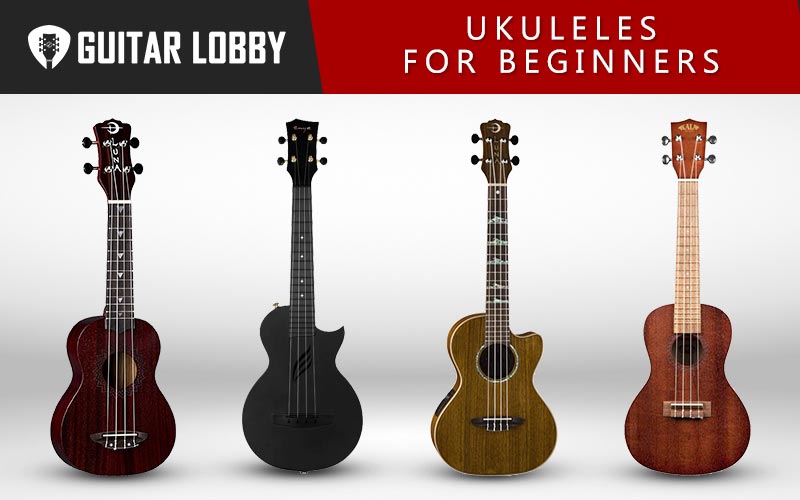
There are a ton of ukuleles on the market and it can seem a bit daunting to navigate it all, but with a few basics and pointers, you can make sure your first ukulele is a great one. Buying the wrong instrument can lead to a hard or impossible time when learning to play, and that is not happy or fun! We’ll start this article by reviewing the best ukulele for beginners at each price point, but if you want to learn more about them before reading reviews, check out the information guide at the bottom of the page here.
| Name of Product | Image of Product | Description | Price Range | Full Review |
|---|---|---|---|---|
| 1. Martin C1K (Best Overall) | 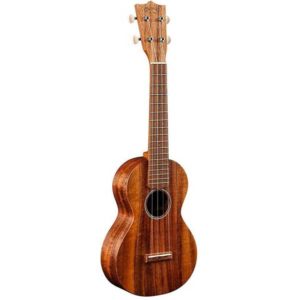 | Style: Concert Length: 23" Fret Count: 17 | $500 | Read Full Review Below |
| 2. Donner DUC-1 (Best Value) | 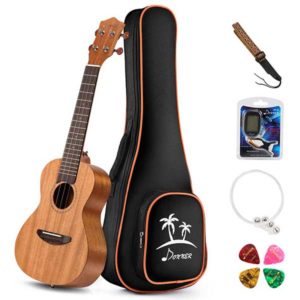 | Style: Concert Length: 23" Fret count: 18 | $70 | Read Full Review Below |
| 3. Kala Learn to Play (Budget Pick) | 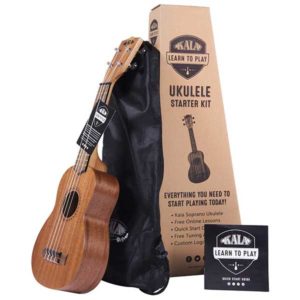 | Style: Soprano Length: 22" Fret Count: 12 | $60 | Read Full Review Below |
| 4. Enya Nova (Editor's Choice) | 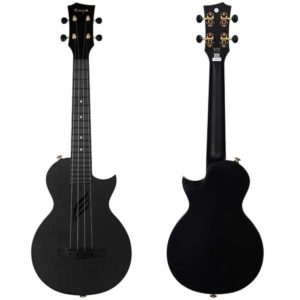 | Style: Concert Length: 23" Fret Count: 18 | $90 | Read Full Review Below |
| 5. Oscar Schmidt OU5 (Best Under $200) | 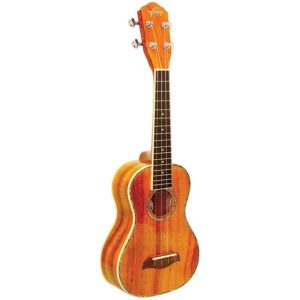 | Style: Concert Length: 24" Fret Count: 16 | $170 | Read Full Review Below |
| 6. Luna High Tide Ovangkol (Best Under $300) | 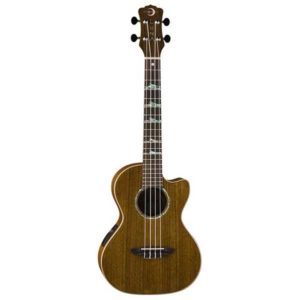 | Style: Tenor Length: 26" Fret Count: 20 | $300 | Read Full Review Below |
| 7. Hola HM-21 | 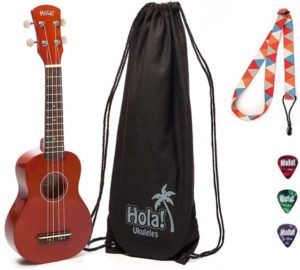 | Style: Soprano Length: 21" Fret Count: 12 | $50 | Read Full Review Below |
| 8. Kala Satin Mahogany | 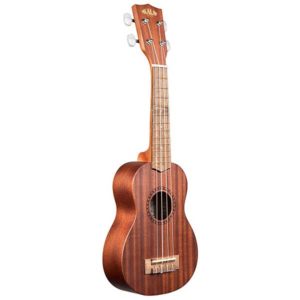 | Style: Soprano Length: 21" Fret Count: 12 | $57 | Read Full Review Below |
| 9. Luna Vintage Mahogany | 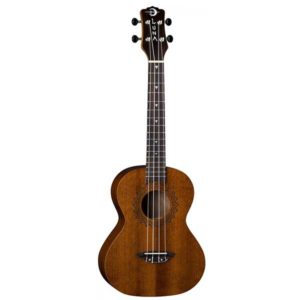 | Style: Tenor Length: 26" Fret Count: 16 | $120 | Read Full Review Below |
| 10. Luna Banjolele | 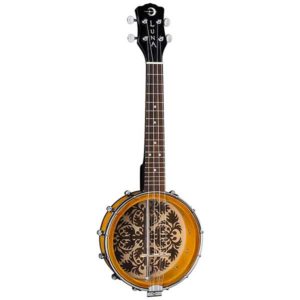 | Style: Concert Scale Length: 15.5" Fret Count: 18 | $200 | Read Full Review Below |
| 11. Mitchell MUB70S | 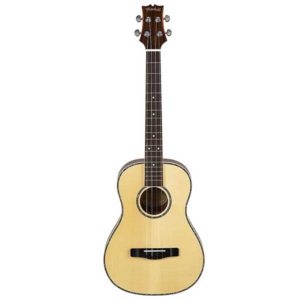 | Style: Baritone Length: 30" Fret Count: 19 | $170 | Read Full Review Below |
| 12. Everjoys Soprano Ukulele | 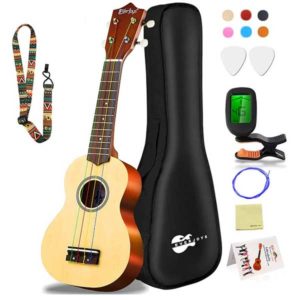 | Style: Soprano Length: 21" Fret Count: 12 | $50 | Read Full Review Below |
| 13. Kmise Concert | 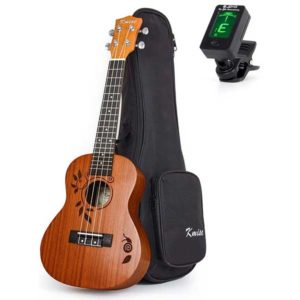 | Style: Soprano Length: 23" Fret Count: 18 | $65 | Read Full Review Below |
| 14. Kala KA 15C Ukulele | 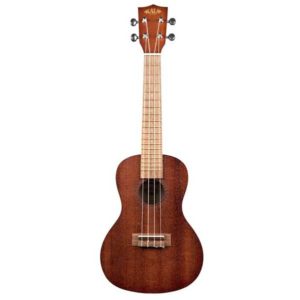 | Style: Concert Length: 24" Fret Count: 18 | $80 | Read Full Review Below |
| 15. Cordoba 20TM-CE | 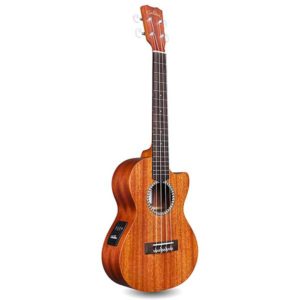 | Style: Tenor Length: 29" Fret Count: 18 | $185 | Read Full Review Below |
| 16. Fender Seaside | 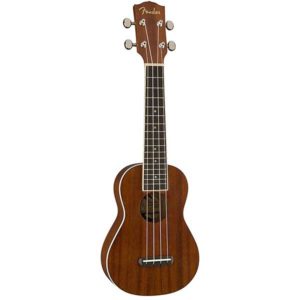 | Style: Soprano Length: 21" Fret Count: 16 | $90 | Read Full Review Below |
| 17. Epiphone Les Paul Acoustic Electric | 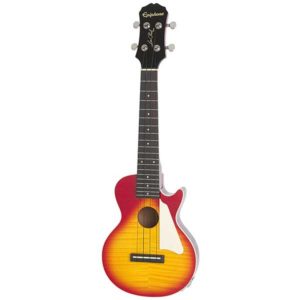 | Style: Concert Scale Length: 15" Fret Count: 19 | $150 | Read Full Review Below |
| 18. Hricane UKS-2 | 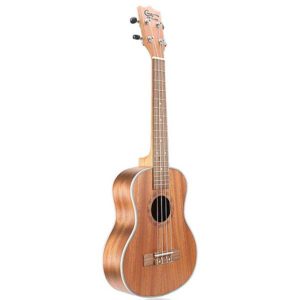 | Style: Concert Length: 26" Fret Count: 18 | $70 | Read Full Review Below |
| 19. Deviser Concert | 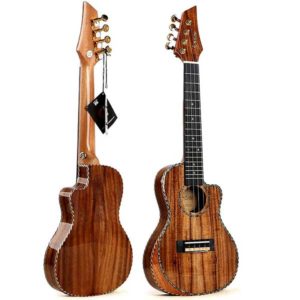 | Style: Concert Length: 23" Fret Count: 18 | $120 | Read Full Review Below |
| 20. Caramel CT905 | 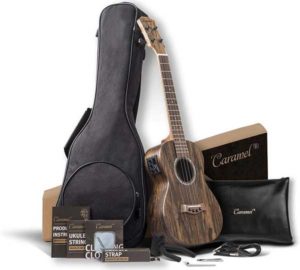 | Style: Tenor Length: 26" Fret Count: 18 | $110 | Read Full Review Below |
Here Are the Best Beginner Ukuleles
1. Martin C1K (Best Overall)
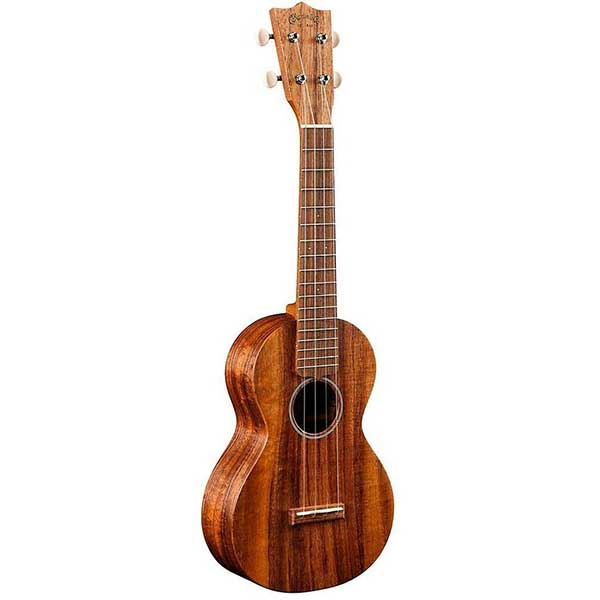
| Estimated Price | $500 |
| Style | Concert |
| Length | 23 in. |
| Fret Count | 17 |
My Review: Martin is not only known for its fabulous guitars; they are also known for making some incredible ukes. If you have the budget and want a classic, a legend, then consider picking up the Martin C1K. It is a beautiful instrument that for the price is incredibly impressive. I feel that this ukulele is well worth the price tag. Let’s discuss some reasons why below!
Key Features: It’s a 23-inch concert size ukulele with 17 frets, all solid wood, and a dovetail neck joint. The tuners are nickel and it has a Tusq nut and saddle. Tusq is similar to NuBone in that it is a synthetic meant to emulate the sound qualities of bone.
Build Materials: All solid koa, like the original ukuleles.
Finish: Satin lacquer
Who Will Use This Most: People who are looking for a top-not uke and aren’t on a tight budget. If you plan on playing professionally, this is the ukulele for you.
Bottom Line: There are other high-end brands and models on this list, but the Martin has the longest proven track record. I have played this uke many times and it’s one of my personal favorites.
2. Donner DUC-1 (Best Value)
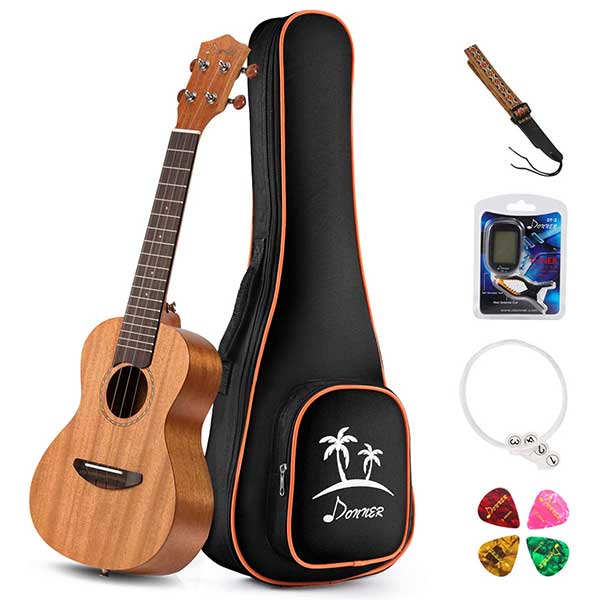
| Estimated Price | $70 |
| Style | Concert |
| Length | 23 in. |
| Fret Count | 18 |
My Review: Donner is an instrument company out of the USA that started in 2012. While not very popular initially, they have grown into a well-known brand for first-time players. They are very similar in sound to other major brands, which is a compliment as they all have great projection for lower budget models.
I happen to like the look and finish of this particular Donner model; it just looks like it costs more, and the soundhole design is nice. There is nothing wrong with making your final ukulele buying decisions on aesthetics, especially with beginner level ukuleles. In this case, it’s a safe bet as plenty of uke players love this ukulele!
Key Features: This concert is 23 inches with 18 brass frets. It also comes with many accessories like a gig bag, a strap, extra strings, and a clip-on tuner. If you want to buy it all at once, this is a great deal.
Build Materials: The entire body is African mahogany while the fretboard is rosewood.
Finish: Satin finish with a rosette design around the soundhole.
Who Will Use This Most: If you want a great beginner ukulele with all the extra accessories then the DUC-1 is a great value. And you get the added benefit of it looking like a more expensive model.
Bottom Line: Donner is another brand with many happy customers. If you like the looks and finish of their models then take the plunge, you will get a great ukulele. Overall, I would say that this is the best beginner ukulele for the money.
3. Kala Learn to Play (Budget Pick)
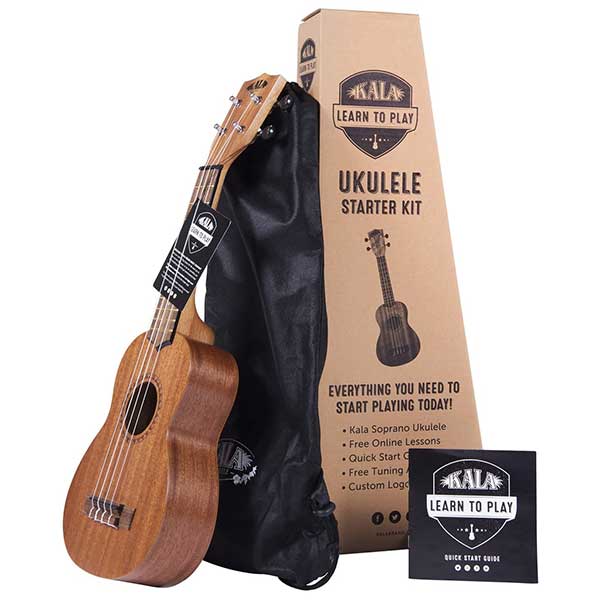
| Estimated Price | $60 |
| Style | Soprano |
| Length | 22 in. |
| Fret Count | 12 |
My Review: You’ll be seeing Kala ukuleles on this most than once on this list and for good reasons. They make excellent ukes at a very affordable price. This model, in particular, is not only great for you, but it also makes an excellent gift because it includes lessons, a booklet, and a tuner app which is all awesome for a new student. It is certainly on the lower end of the budget range, but it delivers hints of performance you’d expend in much more expensive ukuleles.
Because it is an entry-level and very low-cost instrument, keep in mind that you generally get what you pay for. The sound projection isn’t the greatest and it is not sturdy as more expensive ukuleles on this list. But that is the sacrifice we make for wanting to save. However it is still a great first ukulele; and with the right string material tuned up to ADF#B, it will sound bright and happy!
Key Features: At about 22 inches it is a larger size soprano; it comes with a gig bag, online courses, and a Quick Start Guide.
Build Materials: The body is made of mahogany and the fretboard walnut and it also comes with the GraphTech NuBone nut and saddle.
Finish: Natural Satin and a Polynesian shark teeth laser-etched rosette.
Who Will Use This Most: A complete newbie will benefit from this Starter’s kit.
Bottom Line: If you want to dip your toes into the ukulele pool and see if it’s worth a swim, this is a great bargain and a way to get going. As simple as it gets.
4. Enya Nova (Editor’s Choice)
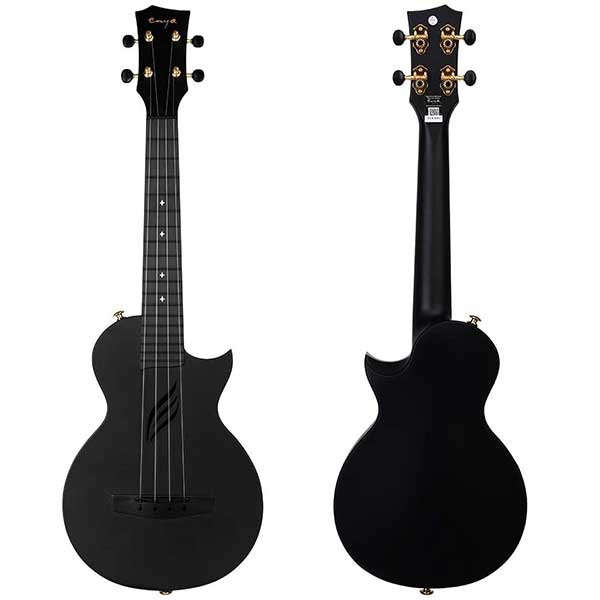
| Estimated Price | $90 |
| Style | Concert |
| Length | 23 in. |
| Fret Count | 18 |
My Review: When I first saw Enya, their unique design caught my eye. While doing research I ended up landing a job writing some of their copy! One day I hadn’t heard of them, the next I was helping them out! Their most popular ukulele is nothing like we have seen on this list. It is made of carbon fiber and looks kind of like a mini electric guitar. It’s not my cup of tea, but still kind of cool. The carbon fiber does provide great sound and lots of sustain. They don’t look like they have a good tone, but they do.
Key Features: This is a 23-inch concert that is all black with gold tuners. The true key feature is that it is truly a unique looking uke! It also comes with accessories like online lessons, strap, capo, extra strings, and a case.
Build Materials: It is all made of carbon fiber and polycarbonate.
Finish: Black, Blue, Pink, White, Orange
Who Will Use This Most: You will know right away if this is the ukulele for you, the design is either going to make you say, “ugh no!” or “awesome!” Depending on the response it will be an easy decision.
Bottom Line: While I have played them, I don’t own one (no you don’t get free ukes when you write about them!). Eventually, I would like to add one to my collection though as they are unique. There is nothing that says you have to buy a traditional ukulele the first time. If you like it, it is totally worth the money.
5. Oscar Schmidt OU5 (Best Under $200)
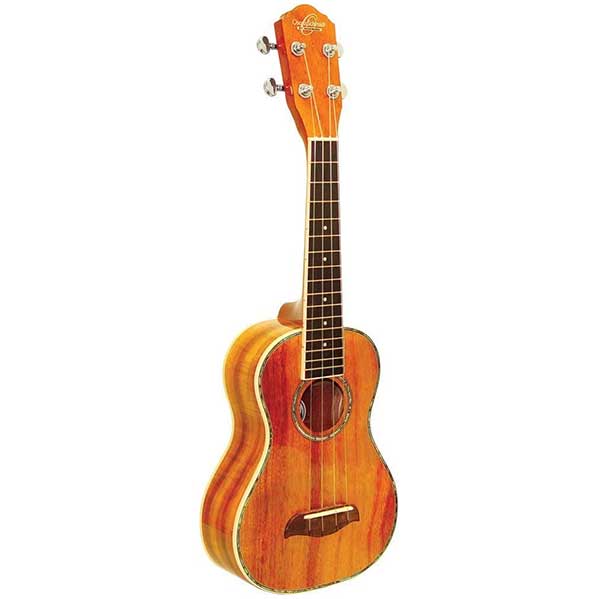
| Estimated Price | $170 |
| Style | Concert |
| Length | 24 in. |
| Fret Count | 16 |
My Review: I am biased as this model was my first nice uke bought 15 years ago. It sounded great then and with age, its sonic qualities have only increased. It has been used on stage and in sold music, I love my OU5. It actually uses koa wood and I think that adds to the brightness. I have had multiple comments on how pretty it sounds.
I would say the only reason not to buy this one would be because of budgetary restraints or you simply don’t like how it looks. Otherwise, it is a fantastic instrument. Oscar Schmidt is a very old instrument company now that is owned by Washburn. They are known for multiple instruments, especially their amazing autoharps. (Which is an instrument I always plug, as it is just as fun to play as the ukulele). I was happy enough with Oscar Schmidt to also buy their baritone ukulele, which was somehow enhanced with magic writing powers to increase song turn out! Or so it seems!
Key Features: This concert ukulele is 24 inches with 16 frets. Like the Kala, it has a slightly larger body size and scale length than most concerts which is what gives it a loud and bright sound.
Build Materials: It is built with koa which seems less common than mahogany these days (likely from cost). However, it also uses nato and rosewood. The nut and saddle are made from ABS, which is a polymer that stands for acrylonitrile butadiene styrene. Of course, ABS is probably the better way to refer to it.
Finish: Natural gloss with abalone binding and rosette.
Who Will Use This Most: If you are a musician or you know you want a more intermediate ukulele, then the OU-5 is a great deal.
Bottom Line: Oscar Schmidt makes great instruments and I can tell you for sure that spending more is worth it. My OU5 is going strong and sounding better every day. This is easily one of the best ukuleles for beginners, especially considering its price.
6. Luna High Tide Ovangkol (Best Under $300)
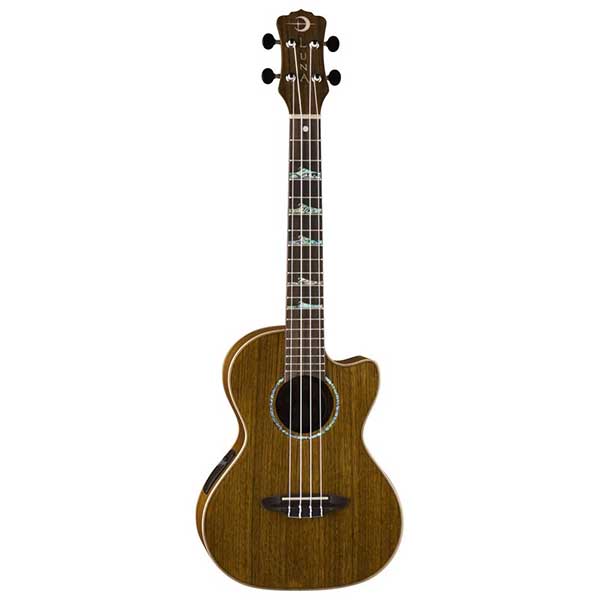
| Estimated Price | $300 |
| Style | Tenor |
| Length | 26 in. |
| Fret Count | 20 |
My Review: Luna ukuleles are often known for their unique designs and tattoo ornamentation, great for buyers that want a little more than the average-looking uke. However, they are not necessary on this Luna due to the gorgeous ovangkol wood. This wood gives a sharp sound with lots of volume. And if that wasn’t enough it also comes with a Luna preamp with a 2 band equalizer for when you want to plug it into an amp. If you have aspirations of playing on stage and the budget, this would be the best ukulele to purchase.
Key Features: This tenor ukulele has a pickup already built-in making it acoustic and electric. It also has a cutaway design so you can play up the frets higher. A ukulele at this price should have great intonation ALL the way up the neck.
Build Materials: Mostly ovangkol, but also maple and mahogany. The nut and saddle are made of plastic.
Finish: Satin with abalone rising waves around the soundhole.
Who Will Use This Most: The musicians who demand quality, great design, and truly unique building materials.
Bottom Line: As a beginner, it is generally not necessary to go over $300, remember they are not difficult to build. Around that price range, you get fantastic sounding solid or laminate wood and a nice setup. This tenor is great for those who know that a good instrument is worth paying for, and know they will be devoting some time to practice.
7. Hola HM-21
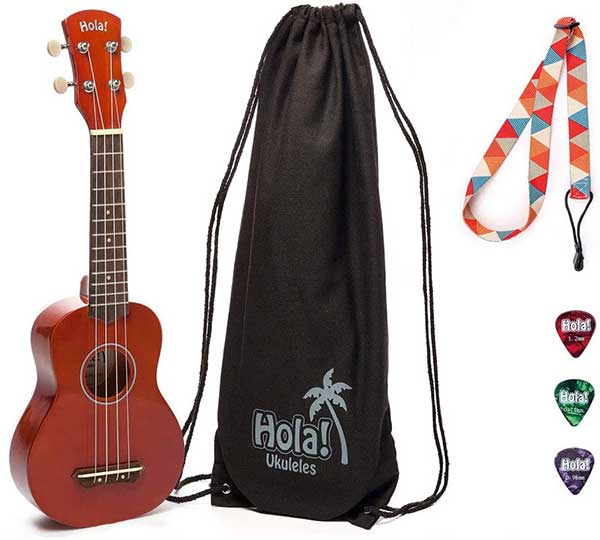
| Estimated Price | $50 |
| Style | Soprano |
| Length | 21 in. |
| Fret Count | 12 |
My Review: You will often find these colorful soprano Hola ukuleles on many best-of lists, as the low price makes them very popular. This is the lowest price on the list and you really shouldn’t go any lower. Clearly many people are happy with these as there are many great reviews, but you run the risk of having issues that you may not know about. However, with the price and all the extra accessories, it does make a great starter uke for kids.
Key Features: It is a 21-inch soprano with a canvas tote bag, straps, picks, and it comes in multiple colors. Straps really are not necessary, but in recent years they seem to be a common item.
Build Materials: The top, back, and sides are made of maple, while the fretboard is rosewood
Finish: Painted in up to 9 colors.
Who Will Use This Most: This is a ukulele for folks who want to make sure they like playing it before spending more money and it is also great for kids. One of the most common reviews for the Hola are teachers who buy them for a whole class.
Bottom Line: If you plan on really trying to learn the ukulele, then I would skip this one. If you want something colorful for the beach or camping, they are sturdy enough to go along for the fun.
8. Kala KA-15S Satin Mahogany
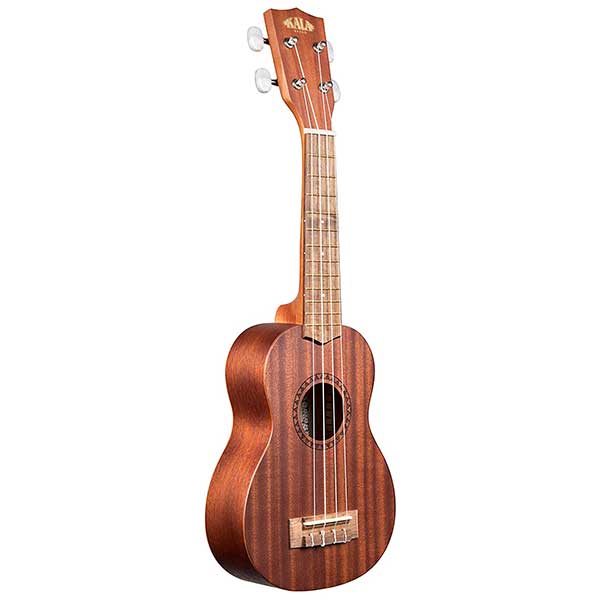
| Estimated Price | $57 |
| Style | Soprano |
| Length | 21 in. |
| Fret Count | 12 |
My Review: Yep, another Kala on the list. This one is also is a great ukulele for a beginner, with no frills, bells, or whistles. It is very similar to the KA soprano above, just a little cheaper and plainer looking. Put a nice set of NylGut strings on one of these and you will have a warm and bright uke to play.
Key Features: This 21-inch soprano has 12 frets and is one of Kala’s most basic models.
Build Materials: It has a mahogany body with a walnut fingerboard.
Finish: Satin
Who Will Use This Most: Those who have a low budget and can’t wait to get started! This simple model will be great to learn on and then in the future you can upgrade.
Bottom Line: If you like how this ukulele looks and it is in your budget, go for it. As usual with Kala, you will get a great instrument. By the time you are ready to get a better one, this basic mahogany uke will still be going strong and can be passed on to another potential player.
9. Luna Vintage Mahogany
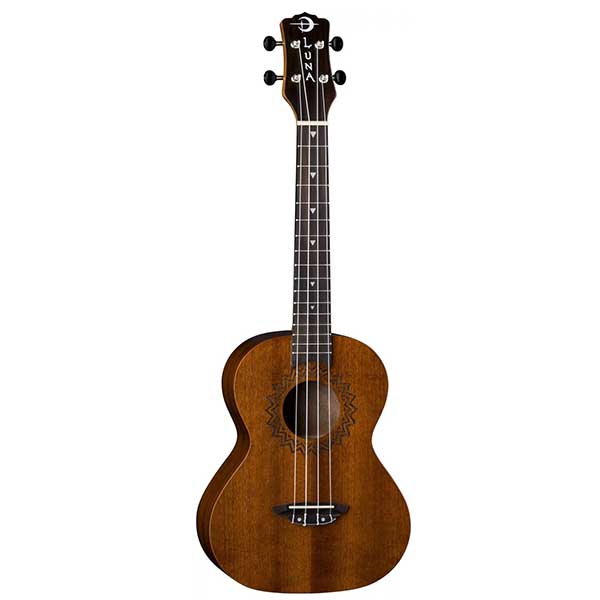
| Estimated Price | $120 |
| Style | Tenor |
| Length | 26 in. |
| Fret Count | 16 |
My Review: It should be no surprise to see another Luna, they build many great ukes even though they are primarily a guitar company. On this ukulele, you can see some of the typical ornamentations they are known for, often Hawaiian tribal tattoo type designs. I am not sure what particularly makes this “vintage” but either way it is a fantastic sounding instrument. Often ukuleles made of all-mahogany have a very rich and warm tone, this model is no exception.
Key Features: This 26-inch tenor has 16 frets with black tuning gears (different than the average chrome). It has a little darker finish than most ukuleles.
Build Materials: All mahogany top, back, and sides with a walnut bridge and fingerboard.
Finish: Satin with pearl triangle inlay.
Who Will Use This Most: If you have a medium-sized budget and want a tenor this is a great buy. As ukuleles get bigger the cost rises so finding a good model in the $100 range is always nice.
Bottom Line: If you like the darker finish and design this Luna will be a great buy. This is a great beginner and intermediate instrument. If you buy this, you won’t really have to upgrade unless you want something more stage-worthy.
10. Luna Banjolele
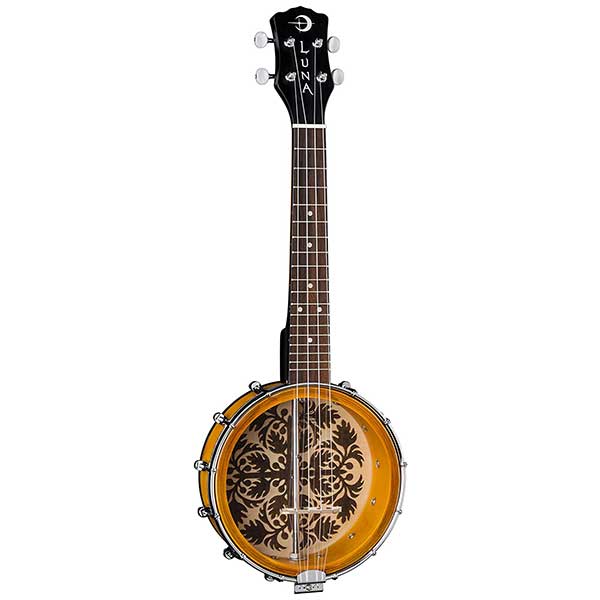
| Estimated Price | $200 |
| Style | Concert |
| Length | 15.5 in. |
| Fret Count | 18 |
My Review: Ok, one last Luna! There are actually more brands these days making banjoleles as they are increasing in popularity. Most of them all sound great, but it seems the Luna banjolele is the biggest seller (likely because it is one of the cheaper ones available). I have to admit I’m not too keen on the design, I prefer my banjo ukes to have a classic white banjo head. Looks aside this Luna has the classic banjolele tone, however, it could project more.
Key Features: It is a concert size and has an 8” mahogany resonator for that banjo sound. The tortoise binding and Ulu design give it a unique look.
Build Materials: Besides the resonator, it also has a mahogany neck and rosewood fretboard. There are 12 brackets in chrome hardware and a floating bridge.
Finish: Matte tobacco burst
Who Will Use This Most: If you want a ukulele, yet you want something different, loud, and old school then you should get a banjolele. It is still a concert size and just like learning any of the ukuleles mentioned so far.
Bottom Line: There are a handful of banjoleles in the $150-200 price range so your choices are limited, that is until more companies start making them (they will). This Luna could pack more of a punch but should satisfy your needs if you have your heart set on a banjolele.
11. Mitchell MUB70S
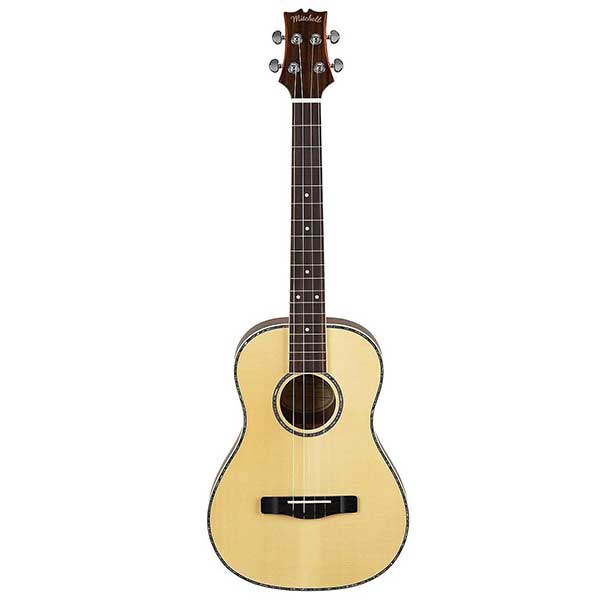
| Estimated Price | $170 |
| Style | Baritone |
| Length | 30 in. |
| Fret Count | 19 |
My Review: We have put every other ukulele on the list except a baritone! Granted they are not usually first time buys, but just in case I included a great entry level bari. Mitchell guitars make a variety of instruments and now they have jumped into the ukulele game. Can you blame them? This particular baritone model is very plain looking, but it gets the job done. It has a solid spruce top that really gives it a nice deep sound and good sustain. Remember if you want a stereotypical ukulele tone, then the baritone is not a great choice. However, it is still a great instrument.
Key Features: This 30 inch baritone with 19 frets has a solid spruce top, and at lower budgets, it is rare to find a solid wood top. This gives it a different color than most ukes.
Build Materials: The top is solid spruce and the sides are made of rosewood. The saddle is also compensated to help the intonation (that means the saddle is not the same all the way across)
Finish: Natural gloss with abalone rosette.
Who Will Use This Most: As I mentioned above the baritone is a great instrument for songwriters. However, for most people, the baritone is a later purchase after they have developed the full-blown gear/ukulele acquisition syndrome.
Bottom Line: If you have your sights set on a baritone, then pick it up. Just be sure to do a good inspection when you get it as string buzzes can be a common problem on baritones.
12. Everjoys Soprano Ukulele
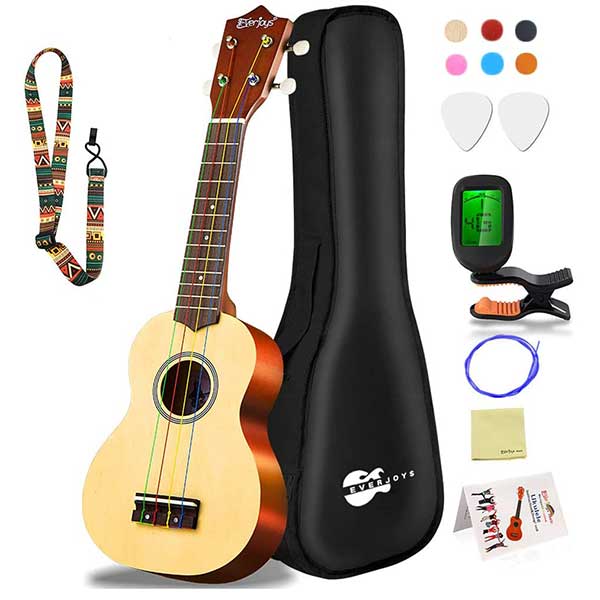
| Estimated Price | $50 |
| Style | Soprano |
| Length | 21 in. |
| Fret Count | 12 |
My Review: Everjoys is a brand that I have been seeing more of recently. They are similar to the Hola’s above in that they are cheap and colorful. Some of these low-cost brands don’t seem to even have websites, they are just sold on amazon and similar sites. Like the Hola, these will be right on the verge of a proper instrument to learn on. They have rainbow-colored strings that look cool but don’t provide the greatest sound. The best part about this particular soprano is all the accessories it comes with. Like the Hola, this is another great ukulele to take on travels and is also perfect for kids.
Key Features: This is a 21-inch soprano with rainbow-colored strings. It also comes with a carrying case, digital tuner, straps, picks, a songbook, polishing cloth, and spare strings. All the accessories may be worth more than the actual ukulele!
Build Materials: The top, back, and sides are made of basswood, the fretboard of rosewood, and the bridge is made of maple. Basswood is on the lower end of tonewoods.
Finish: Natural gloss with a simple design around the soundhole.
Who Will Use This Most: Like the Hola, this is good for kids and anyone who is working with a low budget. Everjoys are popping up on more sites so they clearly have some fans.
Bottom Line: If you are buying in bulk for students or want to make sure you are going to like playing before spending a lot of money, the Everjoys are OK buys. The colored strings may also be helpful for some students, but that could also be a hindrance in the long run. It is usually better to learn chord shapes rather than note colors. However, it’s genius for first time tuning and restringing!
13. Kmise Concert Ukulele
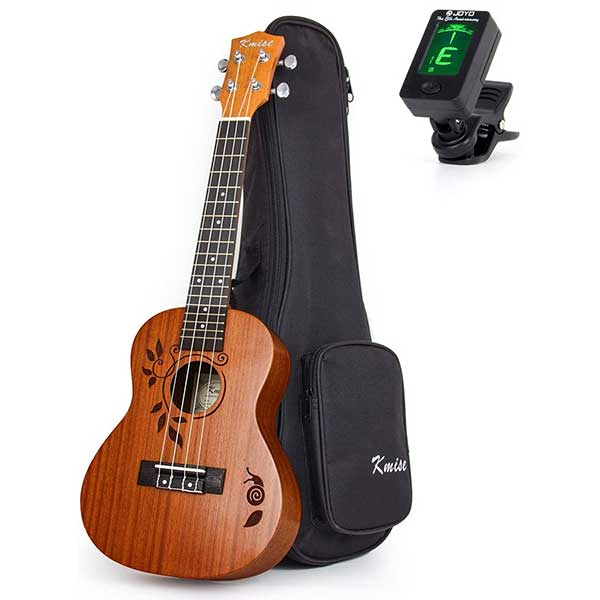
| Estimated Price | $65 |
| Style | Soprano |
| Length | 23 in. |
| Fret Count | 18 |
My Review: Kmise is another low budget model that is currently without a main website, but they still have a lot of sales and plenty of great reviews. Like Luna ukes, the Kmise have a little more to them design-wise. This particular concert model has a nice leaf-like design on the top. In general, Kmise has the usual pleasant but low budget sound. If you aren’t looking for a concert, but like the Kmise you will find the other sizes are good buys too. Remember at this budget a lot of ukes sound the same, so it’s fine to go for a particular design or even wood if you wish.
Key Features: It is a 23-inch soprano with 18 frets and a laser-etched design.
Build Materials: The top, back, and sides are made of Sapele, the neck of Okoume, and it has a real bone nut and saddle.
Finish: Natural matte
Who Will Use This Most: For those with a lower budget, yet they want something more than a regular plain finish. The Kmise is just as suitable as other models in the $60 range.
Bottom Line: Given how bad the spelling and writing can be on some of their sales pages you would think that’s a worrisome sign, but there are many great reviews and they really don’t sound bad at all. If you like the design, buy a Kmise.
14. Kala KA 15C Ukulele
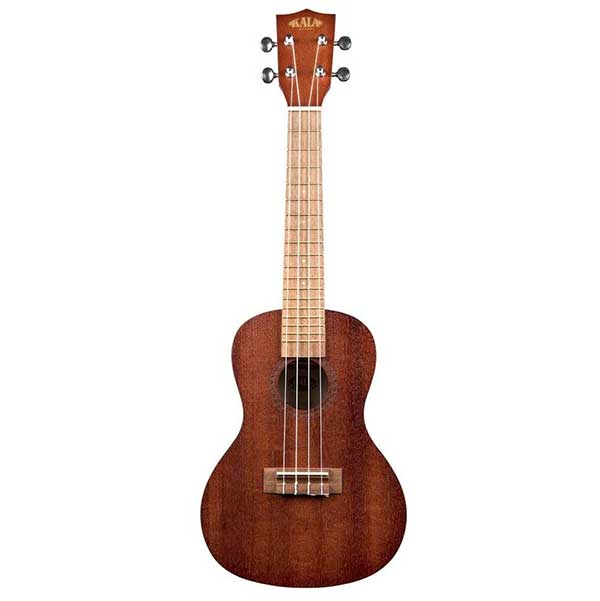
| Estimated Price | $80 |
| Style | Concert |
| Length | 24 in. |
| Fret Count | 18 |
My Review: The Kala company is based out of San Francisco and has been making great ukuleles for years, it is very common to see them on “best of” lists because they make some of the best ukuleles. This uke deserves the top overall spot because it comes from the KA series which includes all sizes. This particular link above is for a concert, which is the size I recommend to beginners.
If this particular size or series doesn’t suit your fancy, it is very likely another Kala model will work just as well. They also make a lower budget brand known as Makala, which I have owned the tenor and baritone Makala and they sounded great. However, as a beginner, it would best to stick with a little better model, preferably the KA above. Put a set of Aquila Nylgut strings on this concert ukulele above and I bet it will sing!
Key Features: The overall instrument length is roughly 24 inches, making it a very large size concert with 18 frets.
Build Materials: The top, back, and sides are all made of mahogany, while the fingerboard is walnut. The nut and saddle are made with a material called Graph Tech NuBone. Originally nuts and saddles were made with real bone and the synthetic NuBone is meant to simulate it.
Finish: Satin
Who Will Use This Most: Basically any new ukulele student will appreciate and enjoy this ukulele!
Bottom Line: This Kala KA can be found in soprano, concert, tenor, and baritone. Of course, depending on the model the price will change slightly, but they are all affordable models. Regardless of the size you want, this Kala series has you covered for a first time ukulele. And while I cannot prove it, I would bet Kala has the greatest reviews. This is definitely the best ukulele overall.
15. Cordoba 20TM-CE
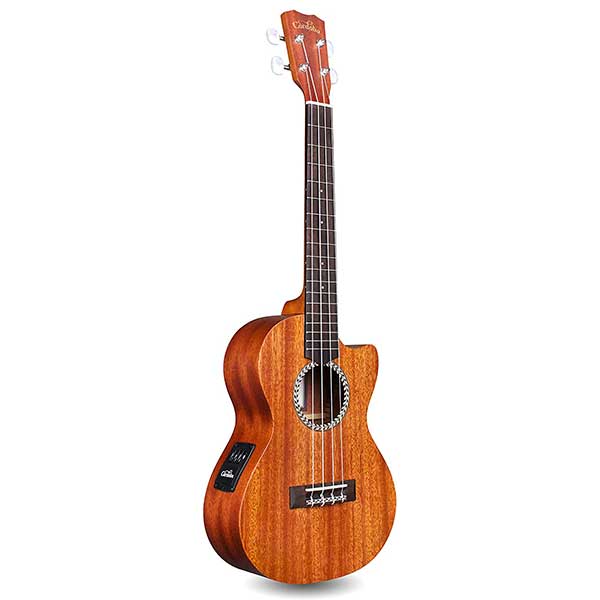
| Estimated Price | $185 |
| Style | Tenor |
| Length | 29 in. |
| Fret Count | 18 |
My Review: Cordoba makes a variety of instruments in northern California, they used to be a very common name on best ukulele lists until recently with the flood of many new companies. I have played their guitars and ukuleles; they are generally quality products. Their prices are often a little higher and in the intermediate budget range. The 20TM is an electric-acoustic tenor and one of their most popular models. If you want a decent model for some open mic nights, this might just be perfect.
Key Features: It is a 29-inch cutaway tenor allowing you to play higher up the 18 frets, the top is solid mahogany and it comes with a preamp and 2 band EQ.
Build Materials: The top is solid mahogany which is a huge plus and the backs and sides are also made of mahogany. The fretboard and bridge are made of rosewood.
Finish: Natural satin
Who Will Use This Most: This instrument is on the pricier side, so it is for the first time player who plans on taking the ukulele seriously. With the pickup and cutaway shape, it will make a good starter stage instrument until you can afford a better model.
Bottom Line: It is common to see reviews that say the Kala models are far superior to Cordoba. There is no doubt they have different tones. If you like the look of the Cordoba watch some videos to get an idea of whether you will like the sound, that way you know ahead of time which you will like better.
16. Fender Seaside
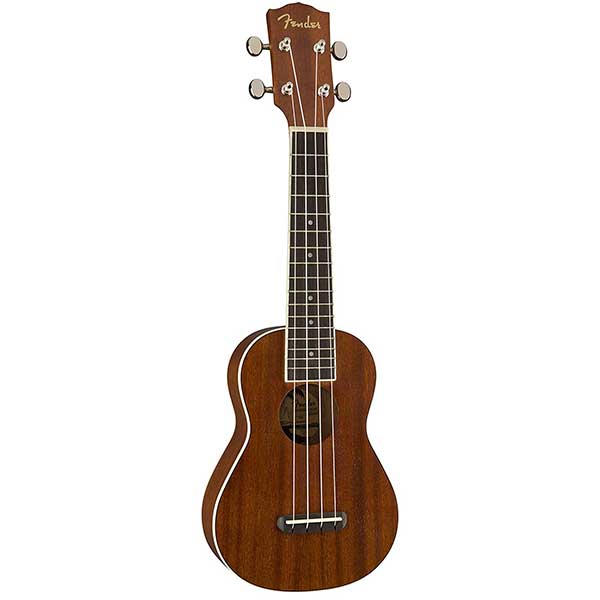
| Estimated Price | $90 |
| Style | Soprano |
| Length | 21 in. |
| Fret Count | 16 |
My Review: Of course with all these new companies jumping in the ukulele wave, already established builders are trying their hands at it too. Fender has multiple models in a variety of sizes, but this Seaside soprano seems to be one the more popular. It is rather plain-looking with no spectacular designs, but it still plays great. This Fender is right on target for a moderate priced ukulele that will sound good and get you playing without breaking the bank.
Key Features: It is a 21-inch soprano size with white binding and a no-tie bridge. Normally uke bridges have the strings knotted around them. It’s normally not a problem, but Fender has made it quicker to string this ukulele up.
Build Materials: The top, back, and sides are mahogany. If you get the Zuma model instead of the Seaside it will have a guitar-like headstock.
Finish: Open pore satin
Who Will Use This Most: Usually musicians that are already playing another instrument like guitar will end up buying a name they recognize when they decide to start the ukulele. Either way, it is just as suitable for beginners as other similar priced ukes on the list.
Bottom Line: Like Martin, Fender is a name you can trust. But that doesn’t mean they necessarily make an awesome ukulele; it is going to have a sound much the same as other entry-level models.
17. Epiphone Les Paul Acoustic Electric
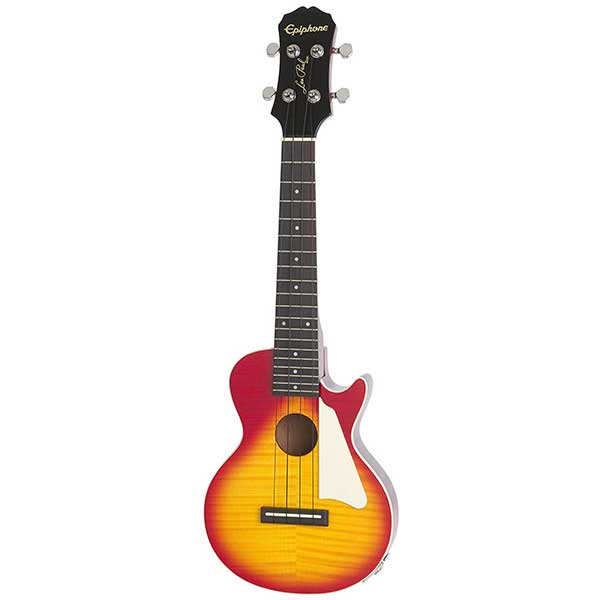
| Estimated Price | $150 |
| Style | Concert |
| Length | 15 in. |
| Fret Count | 19 |
My Review: Epiphone also jumped on the ukulele bandwagon, and they are included here because they made this unique model. Well, it’s not exactly unique as it is essentially a shrunken Les Paul shape. And despite that shape, it surprisingly sounds pretty good. Like a Les Paul, it also comes with a pickup so you can plug it into an amp. This is definitely a ukulele specifically for someone who likes the shape and sunburst color. If I were buying a ukulele as a gift, I would skip this and go with something more traditional.
Key Features: This concert comes in a classic rock style and is a little larger than others giving it a louder sound. The pickup is a passive piezo and it comes with a gig bag.
Build Materials: The top is a flaming maple veneer, the neck mahogany, and the fretboard rosewood.
Finish: Polyurethane in vintage sunburst.
Who Will Use This Most: Like the Fender, this will mostly be used by players who are coming over from the guitar and by people who like to collect a variety of styles.
Bottom Line: Epiphone is also a name you can trust; they usually build quality beginner instruments and this ukulele is no different. As with most odd-looking models whether you want to buy this or not will be based on whether you like the classic rock style.
I am sure I missed some other great ukuleles that are worthy of a beginner player. While I showed a carbon fiber example, I left plastic ones out. Kala makes a very popular plastic model called the Waterman and is perfect for taking to the beach or lake. It’s just on the very low end of the budget where we can run into problems. I have given many music lessons over the years, a poorly setup instrument is the cause of many “failures.” Kids and adults who gave up in frustration thinking they were bad.
If you want to see more models the best thing to do is visit the manufacturer’s websites. Not all builders sell directly but you’ll see all the varieties to choose from, and you may stumble upon something you wouldn’t have seen on the most popular lists. And don’t forget if you have a little higher budget you can always find a luthier to make you one. A great place to find these independent builders is in ukulele groups on social media. With the knowledge you have gained from this guide you will have no problems finding a great uke.
18. Hricane UKS-2
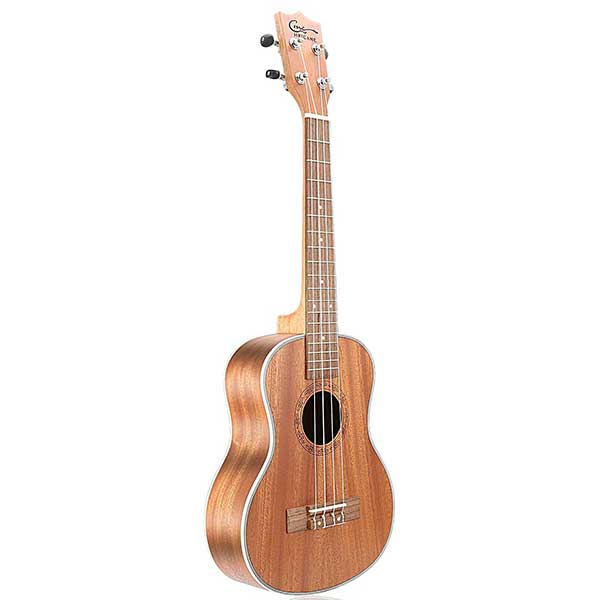
| Estimated Price | $70 |
| Style | Concert |
| Length | 26 in. |
| Fret Count | 18 |
My Review: That is not a misspelling, the company is called Hricane! They started in 2004 and produce low to midrange budget models. The sound they produce is nothing special, you will get a similar quality as other same-priced models. As usual with this price range, the final decision often comes down to looks.
I like the wood grain and design of the particular concert uke, and the strap is pretty cool (yeah, I don’t use straps, but I like this one). Yes, this is another mass produced made in China brand, but it’s hard to find ukes that aren’t!
Key Features: This 26-inch concert has 18 frets and comes with a strap, picks, a tuner, extra strings, and a decent looking padded gig bag!
Build Materials: The top, back, and sides are made of Sapele wood and the fretboard is black walnut. The saddle is made of bovine bone. (Which is odd, not a common material on most ukes).
Finish: Satin finish with binding and ornamentation around the soundhole.
Who Will Use This Most: Beginner players on a budget will likely be the ones to buy this particular concert.
Bottom Line: As mentioned it’s very similar to other models in the same price range. If you have a lower budget and like the looks and the accessories, then the Hricane will suit your needs.
19. Deviser Concert
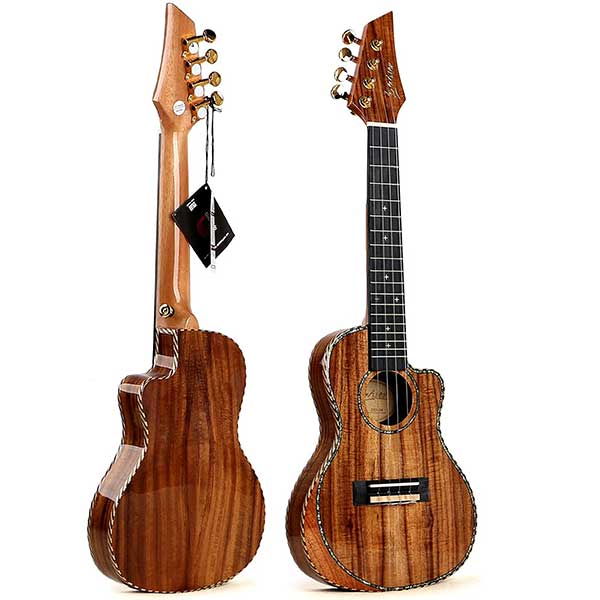
| Estimated Price | $120 |
| Style | Concert |
| Length | 23 in. |
| Fret Count | 18 |
My Review: This is another brand that is hard to find info on, but it has great reviews. I automatically am drawn to this model because it is made of koa. These days koa isn’t used as much, which is sad as it sounds so great.
I’m not the biggest fan of the guitar headstock, but it’s not a deal-breaker. It produces a bright sound and you can play up the frets higher, this is a good concert for a first-time buyer.
Key Features: This is a 23-inch concert cutaway ukulele with 18 frets. Like the Fender, it has a guitar headstock. It also comes with a polishing cloth, strap, and padded gig bag.
Build Materials: The top, back, and sides are Koa and the fretboard is rosewood. The nut and saddle are made of Ox Bone, which is similar to the bovine above. Usually, uke builders just say real bone, without naming the animal.
Finish: High gloss with decorative binding and around the soundhole.
Who Will Use This Most: Some players really like these styles of headstocks, and with the cutaway, it gives this concert a pretty sweet look.
Bottom Line: If you are looking for koa wood and want a good starter concert then this Deviser is great. As long as you find the finish and headstock appealing, go ahead and pick one up!
20. Caramel CT905
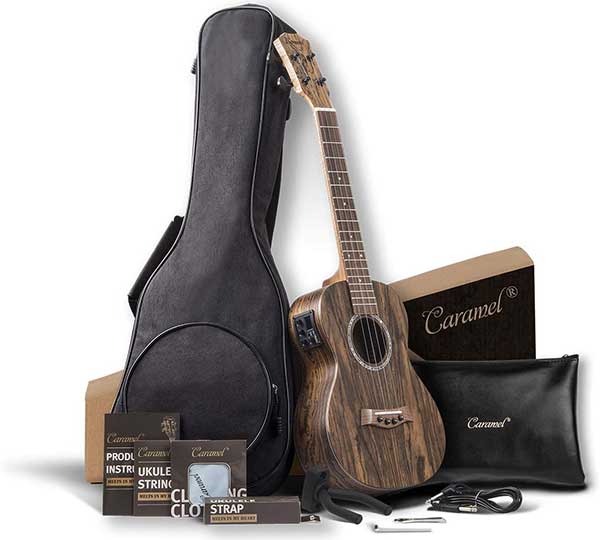
| Estimated Price | $110 |
| Style | Tenor |
| Length | 26 in. |
| Fret Count | 18 |
My Review: Most players may not have heard of this company, but if you want something different than the normal looking mahogany finish, Caramel has it. This tenor is made of butterfly bocote and is a gorgeous looking uke. It has some good accessories and all in all a worthy ukulele for a beginner.
My only concern is that sometimes these strange and exotic woods can be a dud. It’s hit or miss on whether they will sound incredible or dull. With exotic wood, it is sometimes better to play one in person first.
Key Features: This is a 26-inch tenor acoustic/electric. The preamp has a 3 band EQ. It comes with extra strings, padded gig bag, wall mount, and a cord to plug it into your amp!
Build Materials: Bocote wood body, a mahogany neck, and walnut fretboard. It also has a buffalo bone nut and saddle. (Another named bone, perhaps they are all the rage now?).
Finish: Butterfly bocote
Who Will Use This Most: This is for the ukulele player that wants a truly unique looking ukulele.
Bottom Line: At this budget, you will get a decent acoustic/electric tenor. Yeah, it’s a little on the small size for a tenor, but that is likely to keep the budget down. If you love the design and darker wood, this may be the perfect ukulele for you.
I am sure I missed some other great ukuleles that are worthy of a beginner player. While I showed a carbon fiber example, I left plastic ones out. Kala makes a very popular plastic model called the Waterman and is perfect for taking to the beach or lake. It’s just on the very low end of the budget where we can run into problems. I have given many music lessons over the years, a poorly setup instrument is the cause of many “failures.” Kids and adults who gave up in frustration thinking they were bad.
If you want to see more models the best thing to do is visit the manufacturer’s websites. Not all builders sell directly but you’ll see all the varieties to choose from, and you may stumble upon something you wouldn’t have seen on the most popular lists. And don’t forget if you have a little higher budget you can always find a luthier to make you one. A great place to find these independent builders is in ukulele groups on social media. With the knowledge you have gained from this guide you will have no problems finding a great uke.
Choosing the Right Beginner Ukulele (Buying Guide)
If you really want to get the “best” ukulele for beginners that you possibly can, there is a good chance that you will at least be spending in the $100 range. With that kind of cash, it makes sense to do a little research. As with any product, an informed buyer makes a better decision so here are some of the main aspects of ukulele school.
Ukulele Sizes and Tuning Considerations
One of the main reasons the ukulele has such a unique sound is because of its re-entrant tuning. On a guitar, the strings are pitched from low to high, on a ukulele it goes high, low, high again, highest! That and the specific tuning used to give it a very unique sound. The most common tuning is G4 C4 E4 A4 (the 4 shows what octave we are tuning it to when compared to a piano). When you strum GCEA together you get a C6 chord, which is the same tuning as many six-string lap steels, these notes played together just give a Hawaiian vibe.
The GCEA tuning is used on all but the largest ukulele. Other tunings are also used, if you raise your GCEA by one whole step you get ADF#B. This was a very popular tuning in the ’30s and sounds great on soprano ukuleles. The baritone ukulele is a different tuning of DGBE, which is four steps below the GCEA. If you are a guitar player, you will recognize your guitar’s four lower strings are also DGBE.
Don’t try to tune the baritone up to GCEA or you will break a string. Most string companies make a special set of GCEA strings for a baritone, and it is all the rage these days. Honestly, though it seems to dampen and negatively affect the baritone sound. Some people also use a low G string on concerts and tenors, it gives the ukulele a little more bass (and also means you took away the re-entrant tuning). I would actually advise many tenor uke owners to use a low G string as it often enhances the sound and projection. Tenor ukuleles are the best compromise for having the well-known sound mixed with better playability and performance.
Because the soprano, concert, and tenor all have the same tunings you will be able to play them all with the same chord shapes. You can use the same chord shapes on all models, you just remember to transpose the chord four steps lower for a baritone. If you are intimidated by music theory the ukulele will help. As it is such an easy instrument to immediately start playing you will quickly find yourself seeking out new chords and scales. Here are the main differences between the ukulele sizes;
Soprano: This is the original ukulele, when they first gained popularity this roughly 21-inch size uke was the gold standard. It usually has 12-15 frets, however, on lower priced ukes the higher frets are sometimes not very playable. This isn’t a big deal though, as you rarely play that high up. If you are looking for the quintessential ukulele sound, this is it. Often beginners prefer to have a fretboard with more room.
Concert: During the Jazz Age when everyone loved the ukulele, they realized they needed some with more volume. So they increased the size to 23 inches and 15-18 frets, creating the concert ukulele (remember this was still a few decades before pickups and amps). The concert ukulele is one of the better choices for a beginner. It has a few more frets, a little more room on the fretboard, and projects sound far better than the soprano.
Tenor: And of course during the same era they increased the concert to 26 inches and 17-19 frets to make the tenor! The tenor ukulele is another great first time buy, and of course a little more room than the concert. If you plan on doing open mic’s I would buy a tenor; as they project better and more frets means more notes to show off your fingerpicking. You will notice a lot of the big-name ukulele artists often perform with tenors.
Baritone: The baritone is almost like Pluto; it is arguable whether it has been labeled right. It’s kind of a cross between a tenor guitar and a ukulele. It is 29 inches with 18-21 frets and of course tuned differently than the rest. It is generally not a good first time buy. However, it is a secret weapon among songwriters. Because of its weird mixture of a small guitar with a ukulele, it makes it a great instrument to work on new songs.
Banjolele: Unfortunately the banjolele or the banjo ukulele is often left off of many ukulele lists. If you want a LOUD ukulele sound, get a banjolele! The banjo head really gives it push. George Formby and Peter Sellers were both players of the banjolele. Banjo ukes are going to cost more as they have more hardware and aren’t as easy to stamp out. They generally come in roughly concert size and are absolutely wonderful instruments to own.
Sopranino and Bass
There is a uke that is smaller than the soprano called the sopranino, it is actually playable at times. And of course, there are the bass ukes really popping up in the last 10 years. They have big plastic rubbery “strings” and a pickup to somehow attempt uke bass. That’s not a good beginner uke, those are for the people who have serious Gear Acquisition Syndrome. This is when a musician falls so deeply in love with an instrument that they want to buy more! It is a very common condition among ukulele players. And it’s only a problem if you don’t play all of them!
Before we step into some of the build aspects there is one more size issue to be addressed. There are really no such things as “fat fingers.” Many players will often claim to have trouble making certain chords because of their finger size. That’s a bunch of baloney! Yes, different sizes indeed have a little more fretboard space, but it isn’t affecting your ability to chord. With proper technique and practice, you will be able to easily play any chord. Plenty of big people play the uke like Tiny Tim and Israel Kamakawiwo’ole and they have no troubles. (If you really want to see cramped finger space… play the mandolin!)
Woods and Build
Ukuleles are usually made of mahogany and/or koa, historically they were made of the Hawaiian koa. With the recent explosion in interest, you can now find ukes made in everything. Maple, spruce, nato, rosewood, cedar, mango, and so much more. The most important thing to remember is whether the wood is laminated or solid. Solid wood is the best sounding, the most expensive, and even requires more care. Laminated wood is multiple sheets glued and pressurized together. Most beginner models are laminated, but modern tech has still given them a pretty decent sound.
It is common to see sellers make specific claims about the audio qualities of certain woods, but it’s not as simple as they make it sound. Yes, the most popular woods mentioned above are often used as they are reliable on the ukulele sound they produce. But in reality, a tonewood is not the only thing that will affect a ukulele’s overall sound. Even tonewoods of the same species were not grown in the same conditions, so don’t get too worried about the wood. As a beginner, stick to the usual mahogany and koa, and that is always a safe bet.
Plastic is another material you will see ukuleles being built from, during the 50’s craze the most popular uke was the famous plastic Islander model. Its design was based on the famous Martin ukulele, the only difference being the lack of wood. A lot of modern ukes are built using plastics, composites, and other synthetic materials. Really there is nothing wrong with these styles, and some sound pretty great. Many of the recent composite materials (that are also in some modern guitars) actually emulate the sound of wood rather well. If you want your first ukulele to be able to take quite a beating and can be used almost anywhere, plastics are a lot more durable than wood models.
The build is not complicated at all, that is one reason sellers have popped up everywhere. Now you might think if the build isn’t hard, then all low-cost ukes must be the same? Of course not, even if it is an easy build, there are definitely those who know what they are doing better than the rest. The good news is that there are great and affordable companies that are worthy enough to even make it to the top of the list!
Ukulele Strings Considerations
On any stringed instrument, it is essential to put quality and great sounding strings on it. Sometimes cheap ukuleles can be brought to life with great strings. There are a couple of popular brands and years ago I always promoted Aquila as the best. However, I have since learned different ukes respond to specific materials. As a beginner, you are going to start playing and learning some before jumping into changing your strings. Once you get comfortable change the brand and even next time try a different material.
I had a $60 no-name mahogany soprano that sounded dull and cheap. I put Aquila NylGut strings on and what an incredible difference! And ironically Martin ukuleles often sound good with the fluorocarbon strings that they also manufacture. Go figure! Below are the most common types of string, over time give them all a shot until you find one that makes your ukulele sing.
Nylon: There are a variety of nylon polymers used by companies, each having their own patented formula. These days many of them sound very close to the natural gut.
Fluorocarbon: A fancy name for fishing line, some folks love these strings and say they are bright sounding. They do have a different feel than nylon and are the second most popular string material.
Titanium: Strings made from titanium monofilament are popular for increasing tone and projection. They are especially great for concert and tenor sizes.
Metal Wound: The famous ukulele version of Somewhere Over the Rainbow was played using a low G string wound in metal. It is now very common to find silver, copper, or other metals used for these special tunings. Tenor ukes especially respond well to low metal wound strings.
Gut: And this is just like they used to do it in the old days, using animal guts to make the strings. These kinds are very expensive, but you can find them. Honestly, the modern tech materials sound better in most cases. Gut is more suitable for classical musicians.
If you notice you don’t see steel strings, like the ones on guitars and banjos. If you attempt to use steel strings, you will rip the bridge or even worse crack the neck. It will break it because they are not built to withstand that tension. While it is advised to put better strings on a new uke (unless they come with great ones) you don’t rush into it. Play a little and get to know the instrument first, and then find some videos to help you.
One of the biggest complaints on almost all ukulele reviews is that new uke strings don’t stay in tune! They aren’t like guitar strings, sometimes it can take a couple of days before it keeps detuning. It is insanely annoying for a beginner player. As long as you can’t see the gear tuner moving on its own, this stretching is normal. Way too many first time players get frustrated and quit. Just keep a tuner close by and keep tightening it and eventually it will stay on the note. You can learn more about choosing the right strings for your ukulele here.
The 10 Tips for Buying Your First Ukulele
Now that you have some of the basics down you can now start your ukulele shopping, but first, take a close look at some of the pointers below. Stick to these simple ideas when making a purchase and what to do when you receive your ukulele.
1. Being Cheap Is Not Always the Best Option: There are a few times when I bought super cheap instruments and they turned out, meh, Ok. But most of the time they are just bad deals. The musical instrument industry is booming with garbage, exploding at the seams. There is nothing sadder than someone who quits because they think they are terrible when in reality the instrument is just not playable! Obviously, you want to make sure you are going to stick with the hobby before spending a lot, but if you don’t buy a proper ukulele, you’ll never be able to play to find out!
2. Buy Online or Locally: For years the mantra has been shop local at a brick and mortar store. That way you can see and hear what you are buying. The world is changing though, and people mostly buy ukuleles online. If you know a good local shop, I would suggest checking it out, they have most of the models mentioned below. Otherwise, if your situation requires an online purchase, that is fine. As long as you follow the advice below you will still find the best ukulele for a beginner.
3. Accessories: Plenty of ukuleles are being sold with kits these days. In the list below I have added only a couple as they really aren’t necessary. They come with cases, lessons, tuners, felt picks, straps, and all sorts of goodies. Some may find all that helpful, but in reality, most don’t use straps, picks, and some of the cases are not the greatest (If you do buy an expensive uke, you will need a hard case!). Plus you can find a tuner and lessons online. If you want an accessory kit, of course, buy it. However, you will have no problems just ordering the ukulele (and at least an extra set of strings!).
4. Read Reviews: This is one of the sure-fire ways to find a great ukulele. Granted it works best on the highest sellers that have a lot of reviews. Navigating them can be a little difficult, for example, people complain more than they praise. Reviews that are overly angry or ridiculously sycophantic are likely not real, or at least just ranting. Look for reviews where people thoroughly share the pros and cons of what they have bought.
5. Check the Return Policy: Considering most ukuleles are bought online now it is essential to make sure they have a good return policy. And not only a good policy, but paid return shipping. The major companies linked below all offer returns and free shipping on most products. That way if you get a real lemon it’s easy to replace it.
6. Don’t Fret Small Details: When buying a more complicated instrument like a guitar it is good to know the small details about neck profiles, fretboard radius, and the configuration of electronic parts. Even stressing on wood for a ukulele is not a big deal, as lower budget laminate and solids all sound fine. If you are planning on buying a very expensive and professional instrument, then yes definitely pay attention to the “minor” details. Below I will show the major points to keep an eye on.
7. Inspect the Build: This is easier when done in person, but still needs to be done immediately with an online order. Almost all ukuleles today are made in factory-like assembly lines. You would be surprised how many “different” brands are made at the same place. As with any assembly line building, there are going to be bad eggs. Even the best companies below have it happen. In this age of instant buys and fast deliveries, quality control has taken a hit! Check for cracks, tuners that won’t tighten or are loose, bowed fretboards, any frets sticking out, and make sure the bridge is not lifting off. If something looks off find a good social media ukulele group and ask! Other players will always help you out.
8. Look at the Action: On certain stringed instruments, the height of the strings makes a big difference. If the strings are too high off the fretboard, they will be harder to press down (plus that could also mean structural problems). This is usually a bigger deal on steel-stringed guitars, as ukulele nylon strings aren’t that hard to press down on, but you still want good action. If the string is too high it’s hard to play and if they are too low, there will buzzing when other parts hit unwanted frets. When you buy a nice instrument you generally have a setup done where the luthier or seller will get the uke adjusted and ready to play. Of course, lower-priced models don’t often offer this, and they are built in a mass-produced way making it hard to give it a proper setup. So if you have a lower budget you have to make sure the initial setup will be suitable for playing.
9. Check the Intonation: When you pluck the open top string on a soprano, the note will be G. If you place your finger on the first fret you have G#, the second fret F. Each fret is a semitone or half step up from the next. If each fret sounds the note it is supposed to, then the intonation is great. If you have bad intonation the instrument may be unplayable. Keeping a tuning app on your phone with the chromatic scale and tuner is a great way to help check the intonation. On some stringed instruments it can be adjusted, but not with the glued bridge on the ukulele.
10. There Will Be Frustration Before the Happy: On some ukuleles, especially the lower cost ones it can take forever to get the instrument to be playable! The re-entrant tuning can get confusing for some beginners and the strings sometimes stretch forever! Don’t get frustrated if it seems to be going out of tune. Just use your tuner often and make sure you are tuning the string each time to the right note and octave. If the gears move as it slips, that needs to go back, otherwise, just be patient it will set eventually.
On our list below we are going to show you some of the best buys first, and then runners-up which are honestly still great buys. You will notice that we hardly drop below $50, yet online there are a plethora of ukes nearly half that price. It sounds tempting to buy a ukulele for $30, but it is quite simply a glorified toy at that point. The intonation is so very important! And you are taking a gamble buying below $50. A great beginner budget is around $80-120. This range will get you started on a playable and lovely sounding beginner ukulele.
You will also notice that most models below come in a variety of sizes. If you like a certain brand and model it is usually possible to find them in soprano, concert, and tenor. Baritone is not as easy to find, and some companies do not even make that size. And while it is possible to buy an acoustic-electric ukulele, almost any acoustic you buy below can always have a pickup added to it. This means even if you buy a plain acoustic, you can electrify it later!
Ukulele Diagram
The ukulele is one of the easier stringed instruments to build, which means it is not made up of many parts. At the top, we have the headstock that holds the tuners, which allow you to tighten the strings to increase the pitch. Next is the nut where the strings rest at the top, the notches in the nut are cut to fit each specific string size. If they don’t set correctly in the slots, they may make a buzz or be out of tune when you fret a note with your finger.
Next is the neck with all the metal frets on the fretboard, it should be smooth, and the frets should have no sharp edges. The fretboard will have markers along it, that way when you look down while playing you will have a quick visual reference of where you are at note wise. The strings extend across the soundhole and over the saddle onto the bridge. The bridge is glued on, and if you over tighten strings you can rip it right off. I had a vintage soprano ukulele that could no longer take the tension and after many years the wooden bridge gave way, now it only works as a wall decoration!
The body contains the sound hole that leads to the inside. It is this acoustic space that amplifies the vibrations of the strings when you play them. And of course the better the wood, the nicer that sound will be. Sometimes a small pickup is placed inside and then a hole is drilled through to allow it to be both an acoustic and electric ukulele. Most lower priced models are acoustic, they will cost a little extra to have one with a pickup.
And that is pretty much it for the parts, they are so easy to build no wonder there are so many builders in the game. And if you buy a uke and find out you love playing it, it’s totally worth buying a building kit to make your own! If you have a little woodworking skill, it’s a great project.
A Very Short History on Ukuleles
Unfortunately, the beginning of the ukulele is quite the bummer. The Native Hawaiian populations had been decimated by disease and Portuguese immigrants were brought in to fill the labor shortage. They brought with them little guitar-like instruments called machetes, that eventually morphed into the ukulele. Despite the tragic beginnings, the rest of the history is far more uplifting. Once it hit the continental US in 1915 it quickly spread with the help of Tin Pan Alley songs.
It has gone through multiple explosions since; including the 30’s Jazz Age, most of the Beatles and their contemporaries played them, Tiny Tim, during the same era, and of course the more recent craze. In 2007 I remember first seeing and buying a baritone ukulele in a store that had 3 ukes altogether. Now some shops have walls worth and a new builder pops up every month! The popularity is simply crazy, but a testament to what a wonderful instrument it is.
Conclusion
So there you have a long list of the best ukuleles to choose from. If you have the patience, I highly recommend saving a little and getting one of the midrange prices above. If not, then you can’t go wrong with the Kala KA series. Make sure it looks great when you get it and don’t forget it can be a hassle to tune. It may take a couple of days to stretch. A tuner machine or app that shows which octave you are on is the best way to get it tuned perfectly.
The next step will be learning how to play, and you are in luck as there are an abundance of lessons and as mentioned above lots of social media pages. I honestly would have grown tired of the social media scene long ago if not for the music groups. You can find song ideas and get help whether you are a beginner or advanced player. After all these years I still discover new ukulele techniques and tips, and most of it is thanks to these online clubs. And besides all the lessons online I can provide you with a quick hack to jump ahead in skill.
Once you get your uke come back to this page for this quick music lesson. Almost all modern songs follow the same chord progressions, it is legal to use progressions, it’s stealing the melodies that’s the problem. Without diving too deep into music theory, knowing chord progressions allows you to play thousands of songs. Immediately on your uke, you will learn the very easy chords C, Am, F, and G. The first three are simple and even the G isn’t too hard to learn. Start by playing them slowly for a couple of measures and then switching, don’t rush and make sure the chords are sounding clean.
Now play these chords in this order; C-Am-F-G or what is known as the doo-wop progression. With this progression you can play Earth Angel, Monster Mash, Beauty School Dropout, the Beatles used it, as well as Motown, Bowie… everyone uses those same four kids for a bazillion songs. By learning those four chords and looking up common chord progressions, you are on your way to being a fantastic ukulele player! Another famous chord progression is C-G-Am-F, that one has so many songs it could fill a book! People will think you have an incredible ability to play a lot of songs, when in reality you just know the secret of songwriters!
So happy uke playing, you will soon find yourself itching to get another model. It happens to all of us! We start on a concert and before we know it, we want a tenor, baritone, or more! There is no judgment on this bandwagon! Playing the ukulele is one of the happiest things you can do in life, so pick one up as soon as you can!

My name is Chris and I’ve had a passion for music and guitars for as long as I can remember. I started this website with some of my friends who are musicians, music teachers, gear heads, and music enthusiasts so we could provide high-quality guitar and music-related content.
I’ve been playing guitar since I was 13 years old and am an avid collector. Amps, pedals, guitars, bass, drums, microphones, studio, and recording gear, I love it all.
I was born and raised in Western Pennsylvania. My background is in Electrical Engineering, earning a Bachelor’s degree from Youngstown State University. With my engineering experience, I’ve developed as a designer of guitar amplifiers and effects. A true passion of mine, I’ve designed, built, and repaired a wide range of guitar amps and electronics. Here at the Guitar Lobby, our aim is to share our passion for Music and gear with the rest of the music community.
